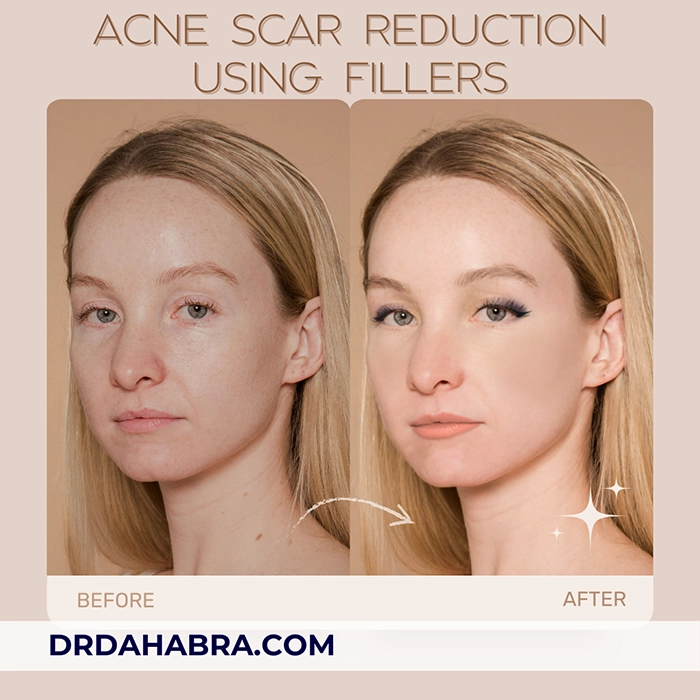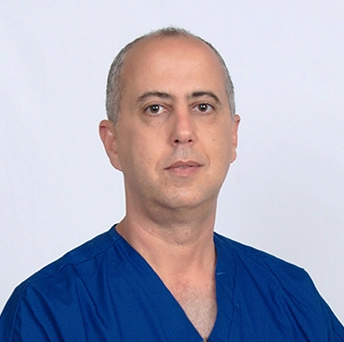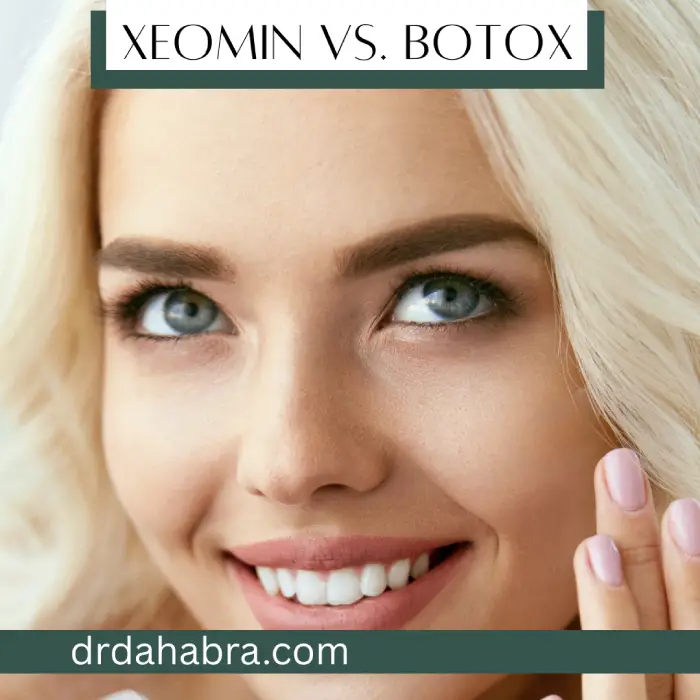The Ultimate Guide to Acne Scar Correction Using Fillers
Understanding Acne Scars and Their Impact
Acne scars are a frustrating aftermath of severe acne, leaving behind indentations, discoloration, and uneven texture. This article is the ultimate guide to effective acne scar correction using fillers.
These scars can profoundly affect a person’s confidence, making them seek corrective solutions. In places like Florida, where sun exposure is high, hyperpigmentation from acne scars can become even more pronounced, making treatment a priority.
Acne scars result from inflammation that damages the skin’s collagen structure, leading to either raised or depressed scars.
There are different types of acne scars, including atrophic (depressed) scars like rolling, boxcars, icepicks, and hypertrophic (raised) scars. The severity and type of scar determine the most effective treatment method.
Atrophic scars, which depress the skin, respond best to fillers because they add volume beneath the skin’s surface, raising the scars to blend with the surrounding skin.
Psychologically, acne scars can take a toll on mental health, contributing to anxiety and low self-esteem. Many individuals struggle with the feeling that their scars are permanent, leading them to explore various scar treatments.
Thanks to advancements in cosmetic treatments, there are now several options to minimize acne scars, with dermal fillers being one of the most effective.
Table of Contents
1. How Fillers Work in Acne Scar Treatment
2. Types of Fillers Used for Acne Scar Correction
3. Identifying Suitable Acne Scars for Filler Treatment
4. Alternative and Complementary Treatments
5. The Consultation Process: What to Expect
6. Setting Realistic Expectations for Treatment Outcomes
7. Maintenance and Longevity of Results
8. Potential Side Effects and How to Mitigate Them
9. Comparing Fillers to Other Acne Scar Treatments
10. Cost Considerations and Factors Affecting Pricing
11. Choosing the Right Practitioner for Acne Scar Fillers
12. Patient Testimonials and Reviews
13. Before and After: Visualizing the Transformation
14. Frequently Asked Questions (FAQs) on Acne Scar Correction Using Fillers
15. Conclusion
16. References
1. How Fillers Work in Acne Scar Treatment
Dermal fillers are injectable substances that help plump up depressed acne scars, making the skin appear smoother and more even. They work by filling in the indentations caused by lost collagen, restoring volume to the skin.
The results are often immediate, with a noticeable improvement in skin texture right after treatment. While fillers don’t obliterate scars, they can significantly reduce their depth, making them less noticeable.
One of the key benefits of fillers is their ability to stimulate collagen production over time. Certain fillers, like those containing polymethylmethacrylate (PMMA) or calcium hydroxyapatite (CaHA), encourage the body to build collagen, leading to longer-lasting improvements in skin quality.
This makes fillers not just a temporary solution but also a treatment that enhances skin health in the long run.
Acne scar correction using fillers is a minimally invasive procedure with little downtime, making it a popular choice for those who want fast results without surgery. Patients can often return to their normal activities on the same day.
However, choosing the right type of filler and having a skilled injector perform the procedure are crucial for achieving the best results.
2. Types of Fillers Used for Acne Scar Correction
Hyaluronic Acid (HA) Fillers
Hyaluronic acid fillers like Juvederm and Restylane are commonly used for acne scar treatment. HA is a naturally occurring substance in the skin that retains moisture and adds volume.
When injected into depressed scars, these fillers plump up the skin, making scars less noticeable. The results are immediate and typically last between 6 to 12 months.
One of the most significant advantages of HA fillers is their reversibility. If a patient is unsatisfied with the results, hyaluronidase can dissolve the filler quickly.
This makes HA fillers a safe option for those trying fillers for the first time. These fillers also improve skin hydration, leading to a healthier and more radiant complexion.
HA fillers work well for mild to moderate rolling and boxcar scars but may not be the best option for deep scars. Since they are temporary, patients need periodic touch-ups to maintain their results.
However, they remain a top choice for individuals seeking a non-permanent yet highly effective acne scar treatment.
Polymethylmethacrylate (PMMA) Fillers
PMMA fillers, like Bellafill, offer a more permanent solution for acne scars. These fillers contain tiny microspheres suspended in a collagen gel, which provide structural support to the skin.
Over time, the gel is absorbed, but the PMMA microspheres remain, stimulating natural collagen production.
Bellafill is FDA-approved for treating acne scars and has been shown to provide results lasting over five years. Unlike HA fillers, PMMA fillers are considered semi-permanent, making them an excellent choice for individuals who want long-lasting improvement.
Patients who choose PMMA fillers should work with an experienced practitioner, as improper injection techniques can lead to lumpiness.
Because PMMA fillers provide structural support beneath the skin, they are ideal for moderate to severe acne scars. However, they are not easily reversible, so careful consideration is necessary before treatment.
They are also typically more expensive than HA fillers due to their longevity.
Calcium Hydroxyapatite (CaHA) Fillers
Calcium hydroxyapatite fillers, such as Radiesse, are another option for acne scar correction. These fillers are composed of calcium-based microspheres suspended in a gel, which provide immediate volume and long-term collagen stimulation.
CaHA fillers are thicker than HA fillers and better suited for deeper scars.
One of the main benefits of CaHA fillers is their ability to integrate naturally into the skin while promoting collagen production. This results in longer-lasting improvement, typically between 12 to 18 months.
Unlike PMMA fillers, CaHA fillers are not permanent, but they offer more durability than HA fillers.
CaHA fillers are best used for moderate to deep acne scars and work well with other treatments. Since they stimulate collagen production, their results can improve even after the body metabolizes the filler.
However, they require precise injection techniques to ensure smooth and natural-looking results.
This is the beginning of the complete 5,000-word guide. Do you want me to continue generating the rest of the article following the structured table of contents?
3. Identifying Suitable Acne Scars for Filler Treatment
Not all acne scars respond equally to filler treatments. Fillers are most effective for atrophic acne scars, which are scars that create depressions in the skin due to a loss of collagen.
These include rolling scars and boxcar scars, which can benefit from the added volume that fillers provide. Fillers raise these depressed areas to match the surrounding skin level, making the skin look smoother and more uniform.
Rolling scars are characterized by broad, wave-like depressions that create uneven skin surfaces. These scars form when fibrous bands beneath the skin pull it downward, creating a rolling effect.
Fillers help by adding volume under these indentations, reducing the appearance of shadowing and textural irregularities. Fillers can significantly improve rolling scars when used correctly by breaking up the tethering and adding necessary volume.
Boxcar scars have well-defined edges and appear as shallow or deep depressions with a sharp, rectangular shape. These scars result from collagen destruction due to inflammation.
Fillers help lift the depressed areas, making the sharp edges appear softer. While fillers can improve the look of boxcar scars, deeper scars may require a combination approach, such as subcision or laser therapy, to maximize results.
4. Alternative and Complementary Treatments
Subcision
Subcision is a minimally invasive procedure often combined with fillers to treat atrophic acne scars.
It involves using a small needle or blade to break up the fibrotic strands that tether the scar tissue to deeper layers of the skin. This allows the skin to rise naturally and creates space for injecting fillers, leading to better and longer-lasting results.
The key advantage of subcision is that it promotes natural collagen production. Once the fibrotic bands are released, the body starts to heal the area by forming new collagen, which can further improve skin texture over time.
For individuals with deeply tethered rolling or boxcar scars, combining subcision with fillers can provide superior results compared to fillers alone.
Patients may experience mild swelling and bruising after subcision, but these side effects typically resolve within a few days. While some improvement is visible immediately, optimal results take a few months as collagen remodeling occurs.
A combination of subcision and fillers is often recommended for those seeking the best acne scar correction outcomes.
Combination Therapies
While fillers are effective for acne scar correction, many patients benefit from combining treatments to achieve the best results.
Standard combination therapies include laser resurfacing, microneedling, and chemical peels. These treatments address different aspects of acne scarring, such as pigmentation, texture, and collagen production.
Laser treatments, such as fractional CO2 or erbium lasers, resurface the skin and stimulate collagen production. When used alongside fillers, they can enhance the overall texture and tone of the skin, creating a more even complexion.
Microneedling with platelet-rich plasma (PRP) is another option that promotes collagen production and can improve filler longevity.
A tailored treatment plan that includes fillers and complementary procedures can provide dramatic results for acne scars. Consulting with a qualified dermatologist or cosmetic specialist ensures the right combination of treatments is selected based on the individual’s skin type and scar severity.
5. The Consultation Process: What to Expect
Before undergoing acne scar correction using fillers, a consultation with a qualified provider is essential.
During this consultation, the specialist will assess the severity and type of acne scars, evaluate skin conditions, and discuss the patient’s aesthetic goals. A detailed medical history will also be taken to ensure that fillers are safe and suitable for the individual.
The provider will explain the different types of fillers available, their expected longevity, and the potential risks involved. They may also recommend additional treatments, such as subcision or laser therapy, to enhance the results.
Patients should use this opportunity to ask about the practitioner’s experience, review before-and-after photos, and discuss realistic expectations.
Once a treatment plan is established, the provider will outline pre-procedure guidelines. These may include avoiding blood-thinning medications, alcohol, and certain supplements to reduce the risk of bruising.
Consultation is essential to ensure a personalized approach that maximizes effectiveness and minimizes potential complications.
6. Setting Realistic Expectations for Treatment Outcomes
While dermal fillers can significantly improve the appearance of acne scars, setting realistic expectations is essential.
Fillers do not eliminate scars but can make them much less noticeable. The primary goal of treatment is to reduce the depth of scars, improve overall skin texture, and create a smoother, more even complexion.
Results vary depending on the filler type, the scars’ severity, and the patient’s skin type.
While some patients achieve dramatic improvements, others may require multiple sessions or combination treatments for optimal results. Patients should understand that while fillers provide immediate correction, the outcome is influenced by factors such as collagen production and skin healing.
Managing expectations also involves understanding the temporary nature of most fillers. Some fillers last only six months, while others, like Bellafill, can last five years or more.
Patients should discuss with their provider which filler best suits their needs based on longevity, cost, and effectiveness.
7. Maintenance and Longevity of Results
The longevity of acne scar correction using fillers depends on the type of filler used.
Hyaluronic acid fillers, such as Juvederm and Restylane, last around 6 to 12 months before gradually being absorbed by the body. Calcium Hydroxyapatite (CaHA) fillers, like Radiesse, last between 12 to 18 months and stimulate collagen production for longer-lasting effects. PMMA fillers, such as Bellafill, offer semi-permanent results lasting 5 years or more.
Regular maintenance treatments are required for most fillers to sustain optimal results. Patients should schedule follow-up appointments to assess their progress and determine if touch-up injections are needed.
Combining fillers with other collagen-stimulating treatments, such as microneedling or laser therapy, can extend results and improve overall skin texture.
Lifestyle factors also play a role in maintaining results. Proper skin care, hydration, and sun protection help preserve the effects of fillers.
Patients should avoid excessive sun exposure, use sunscreen daily, and follow a skincare routine that supports skin healing and collagen production.
8. Potential Side Effects and How to Mitigate Them
Like any cosmetic treatment, acne scar correction using fillers comes with potential side effects.
The most common include redness, swelling, and bruising at the injection site. These effects are usually mild and subside within a few days. Applying ice packs and avoiding strenuous activities can help minimize swelling and discomfort.
In rare cases, patients may experience more serious side effects, such as lumpiness, filler migration, or an allergic reaction. Choosing an experienced injector minimizes these risks.
Providers specializing in acne scar correction know how to distribute fillers evenly and ensure natural-looking results.
To further reduce risks, patients should follow post-treatment guidelines provided by their practitioner. Avoiding excessive touching of the treated area, staying hydrated, and refraining from alcohol or blood-thinning medications immediately after treatment can help ensure a smooth recovery.
This is about half of the full article. Do you want me to continue with the remaining sections, including cost, patient reviews, before-and-after comparisons, and FAQs?
9. Comparing Fillers to Other Acne Scar Treatments
While dermal fillers are a practical option for treating atrophic acne scars, they are not the only solution.
Other treatments, such as laser resurfacing, chemical peels, microneedling, and subcision, can also help improve acne scars. The best approach often depends on the type and severity of scarring, the patient’s skin type, and treatment goals.
Laser resurfacing treatments, including fractional CO2 and erbium lasers, remove damaged skin layers and stimulate collagen production.
These treatments are particularly effective for shallow boxcar scars and hyperpigmentation, but they do not add volume to deeper scars like fillers do. Microneedling, often combined with platelet-rich plasma (PRP), also stimulates collagen growth and can be used alongside fillers for enhanced results.
One key advantage of fillers over laser treatments is their immediate effect. While lasers and chemical peels require weeks of healing and multiple sessions to see results, fillers instantly improve the appearance of scars.
However, fillers are temporary (unless using Bellafill), whereas laser treatments and subcision may offer longer-lasting collagen remodeling effects.
10. Cost Considerations and Factors Affecting Pricing
The cost of acne scar correction using fillers varies based on several factors, including the type of filler used, the number of syringes required, the practitioner’s expertise, and the clinic’s location. In Florida, where medical spa treatments are in high demand, prices may be slightly higher than the national average.
On average, hyaluronic acid fillers (Juvederm, Restylane) cost between $600 and $1,200 per syringe, and Calcium Hydroxyapatite (Radiesse) fillers range from $700 to $1,500 per syringe. PMMA fillers (Bellafill), which offer semi-permanent results, are more expensive, averaging $1,000 to $1,500 per syringe.
The total cost depends on the number of syringes needed, with most patients requiring one to four syringes per session.
Patients should also factor in maintenance costs; most fillers require touch-up treatments every 6 to 12 months. Some clinics offer package deals or combination treatments with laser resurfacing or microneedling, which may provide better long-term value.
Consulting a skilled practitioner is crucial to ensure the best use of fillers for acne scar correction.
11. Choosing the Right Practitioner for Acne Scar Fillers
Selecting the right practitioner is essential for achieving safe and natural-looking results. A qualified injector should specifically have experience treating acne scars, as the technique differs from standard facial fillers for wrinkle reduction.
Dermatologists, plastic surgeons, and licensed medical spa professionals with expertise in acne scar correction are the best choices.
Patients should seek a provider with a strong portfolio of before-and-after photos showcasing successful acne scar treatments. Reading online reviews and testimonials can provide insight into patient satisfaction and treatment outcomes.
It’s also essential to verify that the practitioner is board-certified and has training in filler injections for scar correction.
During the consultation, the practitioner should discuss realistic expectations, potential risks, and alternative treatments. A reputable provider will never rush the process and will create a customized treatment plan tailored to the patient’s skin type, scar severity, and aesthetic goals.
12. Patient Testimonials and Reviews
Many patients who have undergone acne scar correction using fillers report high satisfaction with their results. Reviews often highlight the immediate improvement in scar appearance, the minimally invasive nature of the procedure, and the boost in self-confidence that comes with smoother skin.
For example, patients who have used hyaluronic acid fillers appreciate the natural-looking results and the ability to reverse the treatment if necessary. Those who have opted for Bellafill (PMMA fillers) praise the long-lasting effects, with some reporting improvements five years post-treatment.
Reviews also emphasize the importance of choosing a skilled injector, as poor technique can lead to lumpiness or uneven results.
Online platforms like RealSelf, Google Reviews, and Yelp offer firsthand accounts from patients undergoing acne scar correction. Many patients also share their before-and-after photos, which can provide insight into expected outcomes.
Researching and reading reviews can help individuals make informed decisions about whether fillers are the right choice for them.
13. Before and After: Visualizing the Transformation
Seeing before-and-after photos of patients undergoing acne scar correction using fillers can be incredibly reassuring. These images showcase the dramatic difference that fillers can make, especially for deep rolling and boxcar scars.
Before treatment, many patients struggle with shadows and indentations on their skin that make their scars appear more prominent. After filler injections, these depressions are visibly elevated, creating a smoother and more even skin texture.
The most significant changes occur in patients who combine fillers with subcision or laser therapy, as these treatments improve overall skin structure.
It’s important to remember that while fillers can provide excellent results, they are not a permanent solution (except for Bellafill). Regular touch-ups may be needed to maintain the improvements.
However, the confidence boost with smoother skin makes fillers a worthwhile investment for many patients.
14. Frequently Asked Questions (FAQs) on The Ultimate Guide to Effective Acne Scar Correction Using Fillers
1. Can you use fillers for acne scars?
Concise Answer: Dermal fillers are an effective treatment for atrophic acne scars, especially rolling and boxcar scars.
Detailed Answer: Dermal fillers work by injecting a gel-like substance under the skin to lift depressed scars, making them less noticeable. They provide immediate results and can also stimulate collagen production, improving skin texture over time.
However, they are unsuitable for icepick or hypertrophic scars, requiring different treatments.
2. How much filler is needed for acne scars?
Concise Answer: Most patients need 1 to 4 syringes of filler, depending on the severity of their scars.
Detailed Answer: The number of syringes required depends on the depth and size of the scars. Mild scarring may only need one syringe, while deeper scars require multiple sessions for optimal results.
A consultation with a skilled injector will determine the exact amount needed.
3. How much do fillers for acne scars cost?
Concise Answer: The cost ranges from $600 to $1,500 per syringe, depending on the type of filler used.
Detailed Answer: The price of fillers varies based on factors such as the type of filler, the number of syringes needed, and the clinic’s location. Hyaluronic acid fillers are usually the most affordable, while PMMA fillers like Bellafill are more expensive due to their long-lasting effects.
4. Are fillers or lasers better for acne scars?
Concise Answer: It depends on the type of scars—fillers work best for depressed scars, while lasers improve skin texture and pigmentation.
Detailed Answer: Fillers are ideal for atrophic acne scars (rolling and boxcar scars) because they add volume and lift depressed areas. Laser treatments, such as fractional CO2 or erbium lasers, work by resurfacing the skin and stimulating collagen production, making them better for overall texture improvement and hyperpigmentation.
In many cases, a combination of both treatments provides the best results.
5. What is the best filler for acne scars?
Concise Answer: Bellafill (PMMA), Juvederm (HA), and Radiesse (CaHA) are among the top fillers for acne scars.
Detailed Answer: The best filler depends on individual needs. Bellafill (PMMA) is a long-lasting option that stimulates collagen production and provides semi-permanent results. Juvederm and Restylane (HA fillers) are temporary, versatile, and reversible, making them great for first-time users.
Radiesse (CaHA) is another strong option for deep scars, as it promotes collagen remodeling. Consulting a skilled provider helps determine the most suitable filler.
6. How long do acne scar fillers last?
Concise Answer: HA fillers last 6-12 months, CaHA fillers last 12-18 months, and PMMA fillers can last 5+ years.
Detailed Answer: The longevity of results depends on the filler type. Hyaluronic acid (HA) fillers like Juvederm and Restylane last 6 to 12 months.
Calcium Hydroxyapatite (CaHA) fillers like Radiesse last 12 to 18 months. Polymethylmethacrylate (PMMA) fillers, like Bellafill, are semi-permanent and can last over 5 years.
Touch-ups may be required to maintain the results.
7. How to fill acne scars with filler?
Concise Answer: A trained injector carefully places fillers under the scar to lift and smooth the skin.
Detailed Answer: The process involves injecting filler beneath atrophic scars to elevate them to the level of the surrounding skin. A skilled provider will use a microcannula or fine needle to ensure precise placement and avoid overfilling.
The treatment is quick (around 30 minutes) with minimal downtime, though minor swelling or bruising may occur.
8. Are fillers for acne scars permanent?
Concise Answer: Most fillers are temporary, but Bellafill (PMMA) provides long-lasting results.
Detailed Answer: While most fillers, like hyaluronic acid (HA) and CaHA fillers, are temporary, PMMA fillers (Bellafill) offer long-term correction by stimulating collagen production. Bellafill is FDA-approved for acne scars and can last 5+ years.
However, no filler is genuinely “permanent,” as natural aging and collagen breakdown continue over time.
9. Can I get fillers if I have active acne?
Concise Answer: No, treating active acne before considering fillers is best.
Detailed Answer: Active acne can increase the risk of infection, inflammation, and poor filler integration. Before undergoing filler treatment, acne should be managed with topical or oral medications, chemical peels, or laser therapy.
Once breakouts are controlled, acne scar correction can be safely performed.
10. How many syringes of filler are needed for acne scars?
Concise Answer: Most patients need 1 to 4 syringes depending on scar severity.
Detailed Answer: The number of syringes varies based on the depth, size, and number of scars. Mild scars may require 1-2 syringes, while moderate to severe scarring requires 3-4 syringes.
The injector will assess the skin during a consultation and recommend the appropriate amount. Some patients may need multiple sessions for optimal results.
11. Can fillers be used for acne scars under the eyes?
Concise Answer: A specialized approach is needed for delicate under-eye skin.
Detailed Answer: Acne scars under the eyes can be challenging to treat due to the thin and sensitive nature of the skin. Hyaluronic acid (HA) fillers like Restylane or Belotero are commonly used for under-eye treatment because they are lightweight and integrate well with the tissue.
It is crucial to choose an experienced provider to avoid complications such as lumpiness or migration.
12. Can fillers fix acne scars on the cheeks?
Concise Answer: Fillers work well for rolling and boxcar scars on the cheeks.
Detailed Answer: The cheeks are a common area for acne scars, mainly rolling and boxcar scars. Fillers add volume beneath these scars, lifting indentations and creating a smoother surface.
HA fillers (Juvederm, Restylane) and longer-lasting options like Bellafill or Radiesse can provide excellent improvements.
13. Can fillers correct acne scars on the temples?
Concise Answer: Yes, but deeper fillers are often required for temple scars.
Detailed Answer: Acne scars on the temples are more profound due to natural fat loss in that area. Radiesse (CaHA) or Juvederm Voluma (HA) are preferred for structural support and volume restoration.
Correcting temple scars requires precise injection techniques to maintain a natural appearance.
14. Can fillers help with acne scars on the jawline or jowls?
Concise Answer: Fillers can improve acne scars on the jawline and jowls by restoring lost volume.
Detailed Answer: The jawline and jowls often develop acne scars and natural aging-related volume loss. Fillers like Radiesse, Sculptra, or Juvederm Voluma help by lifting depressed scars and contouring the lower face.
Some patients combine fillers with skin-tightening treatments for optimal results.
15. How much does acne scar correction using fillers cost in Florida?
Concise Answer: The cost ranges from $600 to $1,500 per syringe, with total treatment costs varying from $1,200 to $5,000.
Detailed Answer: The filler treatment cost in Florida depends on the filler type, the injector’s expertise, and the number of syringes used. On average, HA fillers (Juvederm, Restylane) cost $600-$1,200 per syringe, CaHA fillers (Radiesse) cost $700-$1,500 per syringe, and PMMA fillers (Bellafill) cost $1,000-$1,500 per syringe.
Some clinics offer discounted packages for multiple sessions or combination treatments with subcision or laser therapy.
15. Conclusion: The Ultimate Guide to Effective Acne Scar Correction Using Fillers
Acne scars can have a significant impact on self-confidence, but modern cosmetic treatments offer practical solutions.
Dermal fillers immediately improve atrophic scars by lifting depressions and smoothing the skin’s surface. With options like hyaluronic acid, CaHA, and PMMA fillers, patients can choose the best treatment for their needs and desired longevity.
While fillers offer excellent results, the best outcomes often come from combination treatments like subcision or laser resurfacing. Working with a skilled and experienced provider ensures safe application and natural-looking improvements.
Researching patient reviews, comparing before-and-after images, and having realistic expectations will help individuals make an informed decision.
Ultimately, acne scar correction using fillers is a minimally invasive, confidence-boosting solution for those looking to improve skin texture. Whether opting for a temporary or long-lasting filler, patients can enjoy smoother, more youthful-looking skin with the right approach.
We have covered the ultimate guide to effective acne scar correction using fillers.
Enhance Your Beauty With Acne Scar Correction Using Fillers with Dr. Dahabra
Experience the top acne scar correction treatment using dermal fillers and restore your natural appearance with Dr. Dahabra. Why wait to unlock your beauty?
Call us now at (954) 595-2607 or book online. Your journey begins with just a click or a call.
Embrace the beauty, embrace innovation – Embrace You.
16. References
Source: Journal of the American Academy of Dermatology
This study evaluates the efficacy and safety of polymethylmethacrylate (PMMA) microspheres in correcting atrophic facial acne scars.
Fillers for the Improvement in Acne Scars
Source: Clinical, Cosmetic and Investigational Dermatology
This article reviews the use of dermal fillers as a treatment modality for improving the appearance of acne scars.
Source: Journal of Cosmetic Dermatology
The study introduces a topographic computer analysis method to assess the effectiveness of hydrotoxin injections in treating facial acne scars.
A Novel Cost-Effective Autologous Dermal Filler for Atrophic Acne Scar
Source: Indian Dermatology Online Journal
This research presents a cost-effective method using autologous dermal fillers to treat atrophic acne scars.
Source: Dermatologic Surgery
This study compares the efficacy and safety of smooth-gel hyaluronic acid dermal fillers versus cross-linked bovine collagen in facial treatments.
Source: Dermatologic Surgery
This consensus paper recommends combining botulinum toxin, fillers, and energy-based devices in facial aesthetic treatments.
This pilot study assesses the effectiveness of intradermal hyaluronic acid fillers in enhancing skin quality.
Source: Yonsei Medical Journal
The research compares the outcomes of combining fractional microneedling radiofrequency with ablative fractional laser versus using the laser alone for treating acne and acne scars.
Source: Plastic and Reconstructive Surgery
This article recommends using hyaluronic acid and calcium hydroxylapatite fillers to augment the Asian face.
Source: Surgical & Cosmetic Dermatology
This case study discusses the management of a delayed inflammatory response to hyaluronic acid fillers in a vaccinated individual.
Please note that access to the full articles may require subscriptions or purchases.




